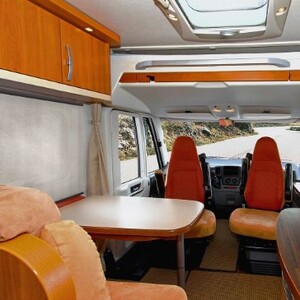Want to buy solar shades for your RV campervan but unsure which openness factor will provide a balance of sun protection, view-through, daytime privacy, natural light luminosity on the road? Here’s a comprehensive solar shade openness comparison to help you choose the right openness for your adventure, i.e. 1%, 3%, 5%, 7%, 10%, and 14%.
Read on to discover how different openness percentages will work best in different areas of your RV travel trailer.
Openness Percentage Explained
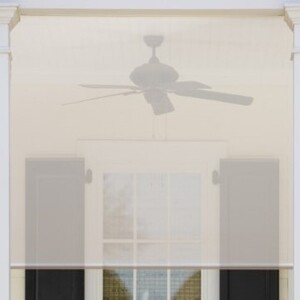
Openness percentage, also known as openness factor or opacity, indicates the degree of openness, density or tightness of the fabric weave, affecting the amount of light that can penetrate through the shade, i.e., 1%, 3%, 5%, 7%, 10%, and 14%. It can also be defined as the ratio of open space or holes to the total surface area of the woven mesh fabric.
Openness percentage of RV solar shades means the level of UV protection, privacy, and view you’ll get on your campervan. For example, an RV solar blind with 10% openness will block out 90% of the sun’s rays, while letting in 10% of the sun’s soft brightness.
Openness factor typically scales between 0% & 14%. Lower openness (1%, 3%, & 5%) will provide better sun protection and privacy but less light and view-through. The reverse is true for higher opennesses (12%, 14% and above). The medium opennesses (7% and 10%) provide the perfect balance of everything, from brightness and UV rejection, to privacy and view-through.
How to Choose the Right Openness of RV Solar Shades for Your Adventure
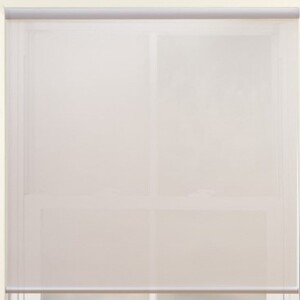
1% Openness Solar Shades for RV’s Bunkroom
Strong, direct sunlight, heat, and prying eyes are a concern on the road? Need maximum sun protection, darkness, and privacy in your travel trailer? Solar shades with 1% openness factor are the best choice. With the tightest, most dense weave, they’ll block 99% of the external light, making your camper truck’s interior a perfect place for sleeping.
Pros
- Nearly complete (99%) light & glare control – only 1% of the fabric is open
- Densely woven fabric – more durable than other loosely woven (higher openness) fabrics
- Highest level of noise protection on the road, compared to solar blinds with higher opennesses
- Best for your RV’s bunkroom to sleep better, deeper
- Fewer open spaces to collect dust & dirt – easy to maintain
Cons
- Sacrificed clarity – minimum outward view
- Minimum natural light – dependence on artificial lighting for visibility in your RV
Practical Tip
If you need total (100%) sun blockage and zero sunlight streaming in your RV, either choose a solar shade with 0% openness or add a blackout liner to your existing 1% openness solar shade.
3% Openness RV Sun Shades for RV’s Media Room
Need rv window sun shades with a bit looser weave to strike a balance between light control and visibility? Select three percent openness, which will let in some (3%) natural light to create a dim glow in your RV’s media room, so you can keep an eye on your kids when enjoying movies.
Pros
- 97% sun control – fair protection against UV damage to RV interior furnishings
- Better heat protection than 5% and higher openness factors
- Some natural light – lower dependence on artificial light compared to 1% openness
- Preserve some degree of outward view
- Moderate glare reduction – comfortable work on screens
Cons
- Limited nighttime privacy when lights are on
- Less clear view compared to higher opennesses
5% Openness Shades for Travel Trailer’s Living & Dining Spaces
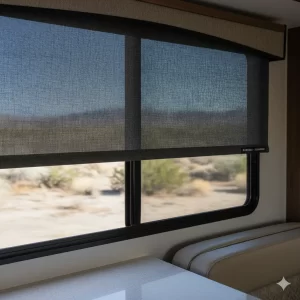
Mostly RV owners looking for sun shades for their RV’s living area, prefer fabrics with 5% openness over other (lower or higher) opacities. 95% opaque fabrics provide adequate sun blockage, sufficient visibility for gossipping, reasonable outward view and the desired level of family privacy on the road. This option will also work best in your campervan’s dining area.
Pros
- Better visibility and slightly more view of the outdoors than 1% and 3% opennesses
- Reduce heat gain in summer – keep your mobile home cooler than the surroundings
- Preserve warmth in winter
Cons
- Less thermal insulation than higher (99% and 97%) opacities
- Slightly less clear view than 7% or higher opennesses
7% Openness for Brightness & Privacy in Your RV’s Kitchen
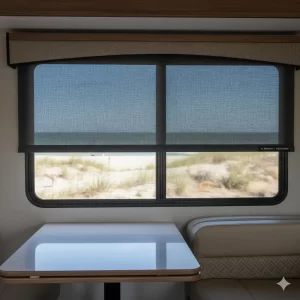
Seven percent or medium openness factor can be a great choice for your recreational vehicle’s cooking space where you’ll need enough light filtering in while also maintaining complete privacy. 7% openness weave also allows heat from the cooker to escape from the top while letting in cooler air from the bottom.
Pros
- Clear, unobstructed view of the outside without letting others see in
- 93% protection of kitchen’s precious furnishings against UV damage
- No dependence on artificial lighting – save on power bills
Cons
- Reduced nighttime privacy
- Less see-through compared to 10% and 14% opennesses
10% Openness Solar Shades for Driver’s Compartment
While driving your camper truck, you’ll like to maintain the best glare-free visibility in your cabin, won’t you? Consider 10% open weave for lots of natural light coming in with only a trace of glare, which won’t affect your safety on the road.
Pros
- A balanced approach to controlling light and maximizing view
- Superior visibility – higher levels of natural light
- Block 90% of the UV light, while maintaining a good degree of glare reduction
Cons
- Interior lights will make the fabric transparent at night
- Incomplete heat insulation – increased air conditioning costs
Expert Advice
If the driver’s compartment faces the sun during most journeys, we recommend RV solar shades made from flame-retardant materials to prevent the sheer fabric from catching fire in the intense solar heat.
14% Openness RV Window Shades for Kids’ Play Area
Have a small kids’ play area with a window in your RV? Looking for RV front window sun shades that offer open-window-like visibility while still ensuring 86% safety from the harsh ultraviolet rays? Select fabric with 14% openness factor.
Pros
- Outstanding visibility
- Maximized exterior view
- Can limit solar heat gain by up to 86 percent
Cons
- Least UV protection compared to lower openness factors
- People on the road may have a blur view of the interior even during the day
5 Steps to Accurately Install Solar Shades on RV Windows to Prevent UV Seepage
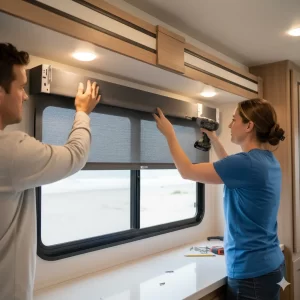
- Step 1: Measure the width & height of your RV window at three different points and use the smallest values for inside mounts and the largest ones for outside mounts.
- Step 2: Align and install snap-in brackets at 180-degree.
- Step 3: Secure brackets with screws.
- Step 4: Snap the headrail into place.
- Step 5: Test the window coverings for smooth operation and make adjustments, if needed.
For detailed instructions, read our easy step-by-step installation for DIYers.
FAQs
What is the best sun shade for RV windows?
Solar roller shades with 7% openness are the best sun shades for RV windows, as they provide substantial (up to 85%) heat reduction, a clear view of the fleeting landscape, and good daytime privacy. With balanced functionalities, they can transform your RVing experience.
What do you put on RV windows to block the sun?
RV reflective sun shades with 10% openness are awesome to keep up to 90% heat out, create privacy, and protect your RV windows and window seals from sun damage, while still allowing UV-free light in the RV. These sun blocking window coverings can help keep your RV 25 to 30 degrees cooler with the AC on.
Should you travel with RV shades up or down?
It depends on the time of the day. If you’re travelling just before or after dawn, keep the RV shades up to enjoy a refreshing smoke-free breeze. In the late morning and afternoon, keep your RV window shades down to keep your RV much cooler than the surroundings.
How to keep heat out of RV windows?
- Reflective insulation with RV blinds and films
- Solar shades for light and temperature regulation
- Exterior sun shades and awnings
- Blackout curtains on the inside
- Ceramic window tint to reduce heat gain without blocking the view
- Park your campervan in natural or artificial shade
What are the disadvantages of solar shades?
- Limited nighttime privacy (when lights are on in your RV)
- Prone to fading (due to prolonged exposure to intense heat on long journeys)
- Prone to damage in windy and stormy weather
Can people see through solar shades at night?
Yes, people on the road can see through solar shades at night when lights are on in your RV and it’s darker on the outside. The see-through effect is reversed during the daytime – you can see out but people on the outside can’t see in.
Need More Help?
We are ready to further assist with choosing the right openness factor for RV roller shades to make your adventure safer and more comfortable. Contact our experts using 24/7 Live Chat or call (800) 490-5720 or email support@rvblinds.com today!

